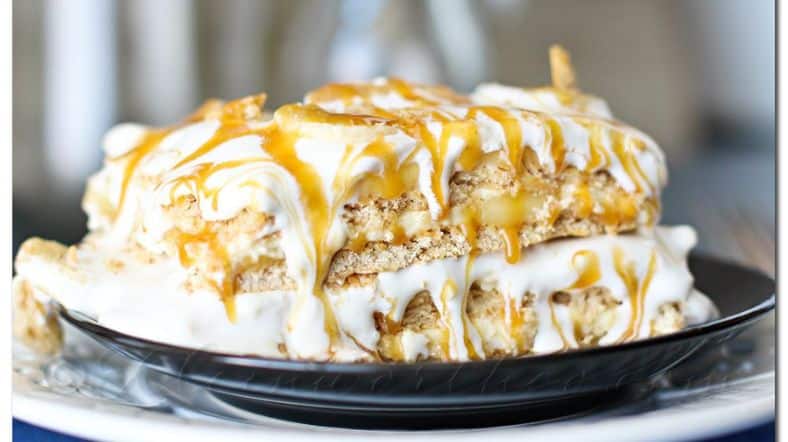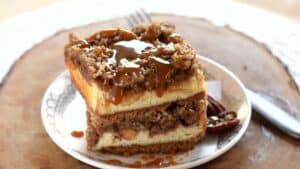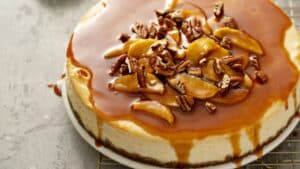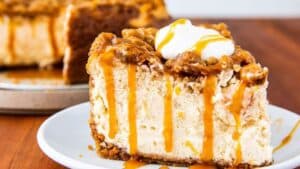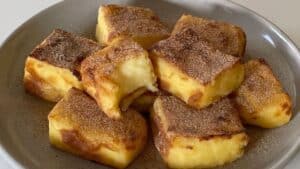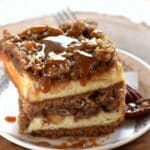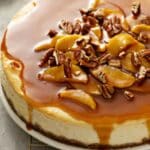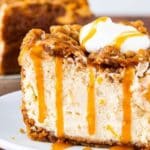There’s a lotta fancy talk in pastry kitchens about soufflés that float like clouds, sugar work like glass, or mille-feuille that shatters under a fork. But nobody talks enough about Caramel Apple Icebox Cake. And that, my friend, is a sin in cream and layers.
This isn’t your cutesy fall dessert. It’s layered nostalgia disguised in cool elegance. Cold, creamy, crunchy, gooey. A pastry paradox. And yet, it works if you build it right.
This article digs deep into how and why the Caramel Apple Icebox Cake deserves a place in the pro kitchen, not just Aunt Martha’s autumn table. We’ll break down its mechanics, flavor science, variations, and yes even a few glorious chef hacks that’ll make your cold cake pop hotter than a brûléed tart.
The Cold Cake That Doesn’t Get Cold Feet
Let’s be honest icebox cakes sound dated. Like rotary phones or aspic molds. But that’s where the genius lies.
Icebox cakes rely on a no-bake technique layered cookies or crackers softened by whipped cream, custards, or mousses. What starts crunchy ends tender. The fridge becomes your oven. Magic? No. Just chemistry. Proteins and moisture marry the layers into one cohesive bite.
Caramel Apple Icebox Cake takes that base structure and elevates it. We’re talking tart apples sautéed in browned butter. Salted caramel drizzled like molten gold. And a whisper of spice tucked into every layer. The cold lets the flavors bloom slowly. No one expects that kind of depth from something this chill.
Anatomy of a Caramel Apple Icebox Cake
You can’t just toss apples and caramel in whipped cream and call it a day. That’s toddler food. Professionals need control. Balance. Structure. Let’s dissect.
The Base – What’s Holding This Thing Up?
Skip the graham crackers, unless you’re mailing it in. Instead, reach for biscoff, gingersnaps, or digestive biscuits. They bring backbone. Spice. Slight bitterness to temper the sweet overload.
Some chefs even bake off a thin speculoos sponge, cut it into sheets, and layer it in. Wild? Maybe. But it slices cleaner. That’s worth something.
Don’t use flaky puff pastry here it goes soggy and weird. Texture is everything in an icebox cake. Crisp to supple, not wet cardboard.
The Apple Layer – Cooked, But Not Dead
Raw apples? Nah. They fight back.
You want Granny Smith, Braeburn, or Pink Ladyapples with real acid and bite. Peel and dice ‘em small. Then hit ‘em with butter, cinnamon, a dust of clove, maybe a splash of bourbon if you’re feeling frisky.
Cook just enough to soften, not collapse. You’re building layers, not applesauce.
And for the love of flavor let the apples cool before layering. Nothing murders whipped cream faster than steam.
The Caramel – More Than Just Sugar
There’s caramel, and then there’s caramel. You know the difference the second it hits your tongue.
Use a dry caramel base no shortcuts with brown sugar and butter. Take white sugar to a deep amber. Almost burnt. Then cut in warm heavy cream, butter, and sea salt. You want it pourable but thick enough to cling.
Make extra. You’ll want to drizzle it over the top and maybe… just maybe… eat it with a spoon in the walk-in.
The Cream Element – Airy, Rich, But Anchored
Here’s where most chefs mess up. They go straight to whipped cream, load it up with sugar, and call it filling. Nope.
You need structure and flavor. Go 50/50: cream cheese and whipped cream, or mascarpone if you’re fancy. Add a bit of crème fraîche or sour cream to sharpen the sweetness.
Sweeten very gently. Let the caramel and apple layers shine.
If you wanna go high-end, stabilize with gelatin. One sheet bloomed in a little warm cream will give you cleaner slices. Don’t overdo it though it ain’t a mousse cake.
Layering Strategy – This Ain’t a Trifle

Layering is choreography. Think structure, flow, contrast. Every forkful should give you:
- Crunch from biscuit
- Spice from apple
- Salt-sweet from caramel
- Cool richness from cream
Start and end with the biscuit layer. That’s your base and your crown.
Keep the apple layer thin too much and it leaks. Caramel goes next, then cream. Repeat. Press down gently with an offset spatula after each cream layer. You’re building flavor compression, not Jenga.
Chill minimum 8 hours. Overnight is better. The rest lets the biscuits go tender, the layers settle. It’s cake alchemy.
Plating for Professionals – The Icebox Cake Glow-Up
This isn’t a rustic sheet pan affair. Presentation counts especially when it’s cold. Cold desserts need warm visual tones.
Finish with a glossy caramel pour, maybe a lace of apple chips or candied pecans. A whisper of smoked salt on top? That’s the kind of detail that makes food critics lean in.
Slice with a hot knife. Wipe between cuts. Let the layers speak.
Serve on dark plates slate, black ceramic. Makes the gold pop. Color contrast tells the story.
Storage, Shelf Life, and Real-World Kitchen Use
Icebox cakes have short legs in a high-turnover kitchen. 3 days tops in cold storage before the texture drops off.
But here’s where smart chefs win: prep the components separately. The cream holds, the apples hold, and biscuits store dry. Assemble a la minute or by daily batch. Easy rotation.
Freezing? You can, but it dulls the apple texture. Better to keep chilled.
Caterers and banquet chefs love these they scale like magic, and there’s no oven time clogging the line.
Variations That Actually Work
Pastry chefs get bored fast. So here’s how you tweak the Caramel Apple Icebox Cake without ruining its soul.
- Brown Butter Pear Version – Swap apples for Bosc or Anjou pears, up the cardamom. Fancy.
- Maple Walnut Crunch – Add crushed candied walnuts between layers. Use maple syrup in the cream.
- Apple Cider Gelée Layer – A thin sheet of set cider between cream and apple gives it bite and bounce.
- Smoked Salt + Black Pepper Finish – Sounds weird, but it elevates the finish into savory territory.
Don’t go too fruity. Berries water it down. Keep it autumnal, rich, and grounded.
The Flavor Science Why This Cake Works
Let’s nerd out a sec.
You’ve got four kinds of sweet:
- Lactose from cream
- Fructose from apple
- Sucrose from caramel
- Maillard-derived depth from browned butter and caramelization
That gives your palate layered sweetness, not flat sugar. Add acid from the apples, salt from the caramel, and fat from the cream. Your mouth gets contrast in every direction.
The fridge melds it all. That’s not romantic fluff it’s real. Moisture migration, fat crystallization, flavor diffusion. It’s like slow food science in dessert form.
Common Mistakes Pros Still Make
Even seasoned chefs screw up cold cakes. Don’t be that chef.
- Rushing the set: 4 hours is not enough. Chill overnight or suffer the ooze.
- Overcooking the apples: Mush kills layers. Texture is your friend.
- Too much caramel: It leaks. Use sparingly between, generously on top.
- Wrong biscuits: Anything with too much fat goes limp, not soft.
- No salt: If your caramel ain’t salted, it’s just syrup with a dream.
Final Takeaways for the Pastry Pro
The Caramel Apple Icebox Cake is your sleeper hit. Easy to scale, deceptively complex, and wildly crowd-pleasing.
It doesn’t scream for attention like a croquembouche. But in the right hands, it sings.
Use it for:
- Fall dessert menus
- Catered corporate luncheons
- Chilled taster flights
- Thanksgiving takeout bundles
It’s low-cost, low-effort, and high-reward when executed with finesse.
Build it smart. Chill it long. Cut it sharp. Finish it bold.
That’s how pros make an old-school dessert feel brand new again.
